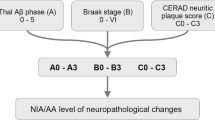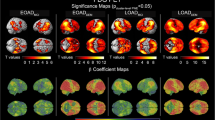Abstract
TDP-43 immunoreactive (TDP-43-ir) pathological changes were investigated in the temporal cortex and hippocampus of 11 patients with autosomal dominant familial forms of Alzheimer’s disease (FAD), 169 patients with sporadic AD [85 with early onset disease (EOAD) (i.e before 65 years of age), and 84 with late onset after this age (LOAD)], 50 individuals with Down’s Syndrome (DS) and 5 patients with primary hippocampal sclerosis (HS). TDP-43-ir pathological changes were present, overall, in 34/180 of AD cases. They were present in 1/11 (9%) FAD, and 9/85 (10%) EOAD patients but were significantly more common (p = 0.003) in LOAD where 24/84 (29%) patients showed such changes. There were no demographic differences, other than onset age, between AD patients with or without TDP-43-ir pathological changes. Double immunolabelling indicated that these TDP-43-ir inclusions were frequently ubiquitinated, but were only rarely AT8 (tau) immunoreactive. Only 3 elderly DS individuals and 4/5 cases of primary HS showed similar changes. Overall, 21.7% of AD cases and 6% DS cases showed hippocampal sclerosis (HS). However, only 9% FAD cases and 16% EOAD cases showed HS, but 29% LOAD cases showed HS. The proportion of EOAD cases with both TDP-43 pathology and HS tended to be greater than those in LOAD, where nearly half of all the cases with TDP-43 pathology did not show HS. The presence of TDP-43-ir changes in AD and DS may therefore be a secondary phenomenon, relating more to ageing than to AD itself. Nevertheless, a challenge to such an interpretation comes from the finding in AD of a strong relationship between TDP-43 pathology and cognitive phenotype. Patients with TDP-43 pathology were significantly more likely to present with an amnestic syndrome than those without (p < 0.0001), in keeping with pathological changes in medial temporal lobe structures. HS was also associated more commonly with an amnestic presentation (p < 0.005), but this association disappeared when TDP-43-positive cases were excluded from the analysis. TDP-43 may, after all, be integral to the pathology of AD, and to some extent determine the clinical phenotype present.

Similar content being viewed by others
References
Amador-Ortiz C, Lin W-L, Ahmed Z, Personett D, Davies P, Duara R, Graff-Radford NR, Hutton ML, Dickson DW (2007) TDP-43 immunoreactivity in hippocampal sclerosis and Alzheimer’s disease. Ann Neurol 61:435–445
Arai T, Mackenzie IRA, Hasegawa M, Nonaka T, Niizato K, Tsuchiya K, Iritani S, Onaya M, Akiyama H (2009) Phosphorylated TDP-43 in Alzheimer’s disease and dementia with Lewy bodies. Acta Neuropathol 117:125–136
Baborie A, Griffiths TD, Jaros E, Richardson A, Ferrari R, Moreno J, Momeni P, McKeith IG, Burn DJ, Duplessis D, Pal P, Rollinson S, Pickering-Brown SM, Thompson JC, Neary D, Snowden JS, Perry R, Mann DMA (2011) Pathological correlates of frontotemporal lobar degeneration in the elderly. Acta Neuropathol 121:365–373
Barker WW, Luis CA, Kashuba A, Luis M, Harwood DG, Loewenstein D, Waters C, Jimison P, Shepherd E, Sevush S, Graff-Radford N, Newland D, Todd M, Miller B, Gold M, Heilman K, Doty L, Goodman I, Robinson B, Pearl G, Dickson D, Duara R (2002) Relative frequencies of Alzheimer disease, Lewy body disease, vascular and frontotemporal dementia, and hippocampal sclerosis in the state of Florida Brain Bank. Alzheimer Dis Assoc Disord 16:203–212
Bigio EH (2011) TDP-43 variants of Frontotemporal lobar degeneration. J Mol Neurosci (in press)
Bigio EH, Mishra M, Hatanpaa KJ, White CL III, Johnson N, Rademaker A, Weitner BB, Deng H-X, Dubner SD, Weintraub S, Mesulam M (2010) TDP-43 pathology in primary progressive aphasia and frontotemporal dementia with pathologic Alzheimer disease. Acta Neuropathol 120:43–54
Braak H, Braak E (1991) Neuropathological stageing of Alzheimer-type pathological changes. Acta Neuropathol 82:239–259
Buratti E, Brindisi A, Pagini F, Baralle FE (2004) Nuclear factor TDP-43 binds to the polymorphic TG repeats in CFTR intron 8 and causes skipping of exon 9: a functional link with disease penetrance. Am J Hum Genet 74:1322–1325
Chui HC, Zarow C, Mack WJ, Ellis WG, Zheng L, Jagust WJ, Mungas D, Reed BR, Kramer JH, Decarli CC, Weiner MW, Vinters HV (2006) Cognitive impact of subcortical vascular and Alzheimer’s disease pathology. Ann Neurol 60:677–687
Crystal HA, Dickson D, Davies P, Masur D, Grober E, Lipton RB (2000) The relative frequency of ‘dementia of unknown etiology’ increases with age and is nearly 50% in nonagenerarians. Arch Neurol 57:713–719
Davidson Y, Kelley T, Mackenzie IR, Pickering-Brown SM, Du Plessis D, Neary D, Snowden JS, Mann DMA (2007) Ubiquitinated pathological lesions in frontotemporal lobar degeneration contain the TAR DNA-binding protein, TDP-43. Acta Neuropathol 113:521–533
Dickson DW, Davies P, Bevona C, Van Hoeven FH, Factor SM, Grober E, Aronson MK, Crystal HA (1994) Hippocampal sclerosis: a common pathological feature in very old (> or = 80 years of age) humans. Acta Neuropathol 88:212–221
Farrer MJ, Hulihan MM, Kachergus JM, Dachsel JC, Stoessl AJ, Grantier LL, Calne S, Calne DB, Lechevalier B, Chapon F, Tsuboi Y, Yamada T, Gutmann L, Elibol B, Bhatia KP, Wider C, Vilarino-Guell C, Ross OA, Brown LA, Castanedes-Casey M, Dickson DW, Wszolek ZK (2009) DCTN1 mutations in Perry syndrome. Nat Genet 41:163–165
Galton CJ, Patterson K, Xuereb JH, Hodges JR (2000) Atypical clinical presentations of Alzheimer’s disease: a clinical, neuropsychological, neuroimaging and pathological study of 13 cases. Brain 123:484–498
Geser F, Winton MJ, Kwong LW, Xu Y, Igaz LM, Garruto RM, Perl DP, Galasko D, M-Y Lee V, Trojanowski JQ (2008) Pathological TDP-43 in parkinsonism dementia complex and amyotrophic lateral sclerosis. Acta Neuropathol 115:133–146
Geser F, Robinson JL, Malunda JA, Xie SX, Clark CM, Kwong LK, Moberg PJ, Moore EK, Van Deerlin VM, Lee VM-Y, Arnold SE, Trojanowski JQ (2010) Pathological 43-kDa transactivation response DNA-binding protein in older adult with and without severe mental illness. Arch Neurol 67:1238–1250
Hasegawa M, Arai T, Akiyama H, Nonaka T, Mori H, Hashimoto T, Yamazaki M, Oyanagi K (2007) TDP-43 is deposited in the Guam parkinsonism-dementia complex brains. Brain 130:1386–1394
Hu WT, Josephs KA, Knopman DS, Boeve BF, Dickson DW, Petersen RC, Parisi JE (2008) Temporal lobar predominance of TDP-43 neuronal cytoplasmic inclusions in Alzheimer’s disease. Acta Neuropathol 116:215–220
Josephs KA, Whitwell JL, Knopman DS, Hu WT, Stroh DA, Baker N, Rademakers R, Boeve BF, Parisi JE, Smith GE, Ivnik RJ, Petersen RC, Jack CR, Dickson DW (2008) Abnormal TDP-43 immunoreactivity in AD modifies clinicopathologic and radiologic phenotype. Neurology 70:1850–1857
Josephs KA, Hodges JR, Snowden JS, Mackenzie IR, Neumann M, Mann DM, Dickson DW (2011) Neuropathological background of phenotypical variability in frontotemporal dementia. Acta Neuropathol 122:137–154
Kadokura A, Yamazaki T, Lemere CA, Takatama M, Okamoto K (2009) Regional distribution of TDP-43 inclusions in Alzheimer disease (AD) brains: their relationship to AD common pathology. Neuropathology 29:566–573
King A, Sweeney F, Bodi I, Troakes C, Maekawa S, Al-Sarraj S (2010) Abnormal TDP-43 expression is identified in the neocortex in cases of dementia pugilistica, but is mainly confined to the limbic system in high and moderate stages of Alzheimer’s disease. Neuropathology 30:408–419
Leverenz JB, Agustin CM, Tsuang D, Peskind ER, Edland SD, Nochlin D, DiGiacano L, Bowen JD, McCormick WC, Teri L, Raskind MA, Kukull WA, Larson EB (2002) Clinical and neuropathological characteristics of hippocampal sclerosis. A community based study. Arch Neurol 59:1099–1106
Lippa CF, Rosso AL, Stutzbach LD, Neumann M, Lee VM-Y, Trojanowski JQ (2009) Transactive response DNA-binding protein 43 burden in familial Alzheimer disease and Down syndrome. Arch Neurol 66:1483–1488
Mackenzie IR, Rademakers R, Neumann M (2010) TDP-43 and FUS in amyotrophic lateral sclerosis and Frontotemporal dementia. Lancet Neurol 10:995–1007
Mann DMA (1988) Alzheimer’s disease and Down’s syndrome. Histopathology 13:125–138
McKhann G, Drachman D, Folstein M (1984) Clinical diagnosis of Alzheimer’s disease report of the NINCDS-ADRDA Work Group under the auspices of Department of Health and Human Services Task Force on Alzheimer’s disease. Neurology 34:939–944
Mirra SS, Heyman A, McKeel D (1991) The consortium to establish a registry for Alzheimer’s disease Part II. Standardization of the neuropathologic assessment of Alzheimer’s disease. Neurology 41:479–486
Nakashima-Yasuda H, Uryu K, Robinson J, Xie SX, Hurtig H, Duda JE, Arnold SE, Siderowf A, Grossman M, Leverenz JB, Woltjer R, Lopez OL, Hamilton R, Tsuang DW, Galasko D, Masliah E, Kaye J, Clark CM, Montine JB, Lee VM-Y, Trojanowski JQ (2007) Co-morbidity of TDP-43 proteinopathy in Lewy body related diseases. Acta Neuropathol 114:221–229
Nelson PT, Scmitt FA, Lin Y, Abner EL, Jicha GA, Patel E, Thomason PC, Neltner JH, Smith CD, Santacruz KS, Sonnen JA, Poon LW, Gearing M, Green RC, Woodward JL, Van Eldik LJ, Krysio RJ (2011) Hippocampal sclerosis in advanced age: clinical and pathological features. Brain 134:1506–1518
Petrovich H, Ross GW, Steinhorn SC, Abbott RD, Markesbery W, Davis D, Nelson J, Hardman J, Curb JD, Blanchette PL, Launer LJ, Yano K, Markesbery WR (2005) AD lesions and infarcts in demented and non-demented Japanese-American men. Ann Neurol 57:98–103
Snowden JS, Stopford CL, Julien CL, Thompson JC, Davidson Y, Gibbons L, Pritchard A, Lendon CL, Richardson AM, Varma A, Neary D, Mann DMA (2007) Cognitive phenotypes in Alzheimer’s disease and genetic risk. Cortex 43:835–845
Stopford CL, Snowden JS, Thompson JC, Neary D (2008) Variability in cognitive presentation of Alzheimer’s disease. Cortex 44:185–195
Uryu K, Nakashima-Yasuda H, Forman MS, Kwong LK, Clark CM, Grossman M, Miller BL, Kretzschmar HA, Lee VM-Y, Trojanowski JQ, Neumann M (2008) Concomitant TAR-DNA-binding protein 43 pathology is present in Alzheimer disease and corticobasal degeneration but not in other tauopathies. J Neuropathol Exp Neurol 67:555–564
Wang HY, Wang IF, Bose J, Shen CK (2004) Structural diversity and functional implications of the eukaryotic TDP gene family. Genomics 83:130–139
Yokota O, Davidson Y, Arai T, Hasegawa M, Akiyama H, Ishizu H, Terada S, Sikkink S, Pickering-Brown S, Mann DMA (2010) Effect of topographical distribution of α-synuclein pathology on TDP-43 accumulation in Lewy body disease. Acta Neuropathol 120:789–801
Yokota O, Davidson Y, Bigio EH, Ishizu H, Terada S, Arai T, Hasegawa M, Akiyama H, Sikkink S, Pickering-Brown S, Mann DMA (2010) Phosphorylated TDP-43 pathology and hippocampal sclerosis in progressive supranuclear palsy. Acta Neuropathol 120:55–66
Zarow C, Sitzer TE, Chui HC (2008) Understanding hippocampal sclerosis in the elderly: epidemiology, characterisation and diagnostic issues. Curr Neurol Neurosci Rep 8:363–370
Acknowledgments
We thank Helen Morpeth in Pathological Services at Salford Royal Foundation Trust for technical assistance. We acknowledge the assistance of Professor Martin Rossor at Institute of Neurology, Queen Square, London in the collection and characterisation of some of the familial Alzheimer’s disease cases. The work of the Manchester Brain Bank, the Thomas Willis Brain Bank, Oxford, and the Institute of Psychiatry Brain Bank is supported by wholly or in part by Alzheimer’s Research UK and the Alzheimer’s Society through the Brains for Dementia Research Initiative. SR is supported by The Sir John Fisher Foundation. MME is grateful for support from the UK National Institute for Health Research via the Biomedical Research Centre.
Author information
Authors and Affiliations
Corresponding author
Electronic supplementary material
Below is the link to the electronic supplementary material.
Rights and permissions
About this article
Cite this article
Davidson, Y.S., Raby, S., Foulds, P.G. et al. TDP-43 pathological changes in early onset familial and sporadic Alzheimer’s disease, late onset Alzheimer’s disease and Down’s Syndrome: association with age, hippocampal sclerosis and clinical phenotype. Acta Neuropathol 122, 703–713 (2011). https://doi.org/10.1007/s00401-011-0879-y
Received:
Revised:
Accepted:
Published:
Issue Date:
DOI: https://doi.org/10.1007/s00401-011-0879-y




